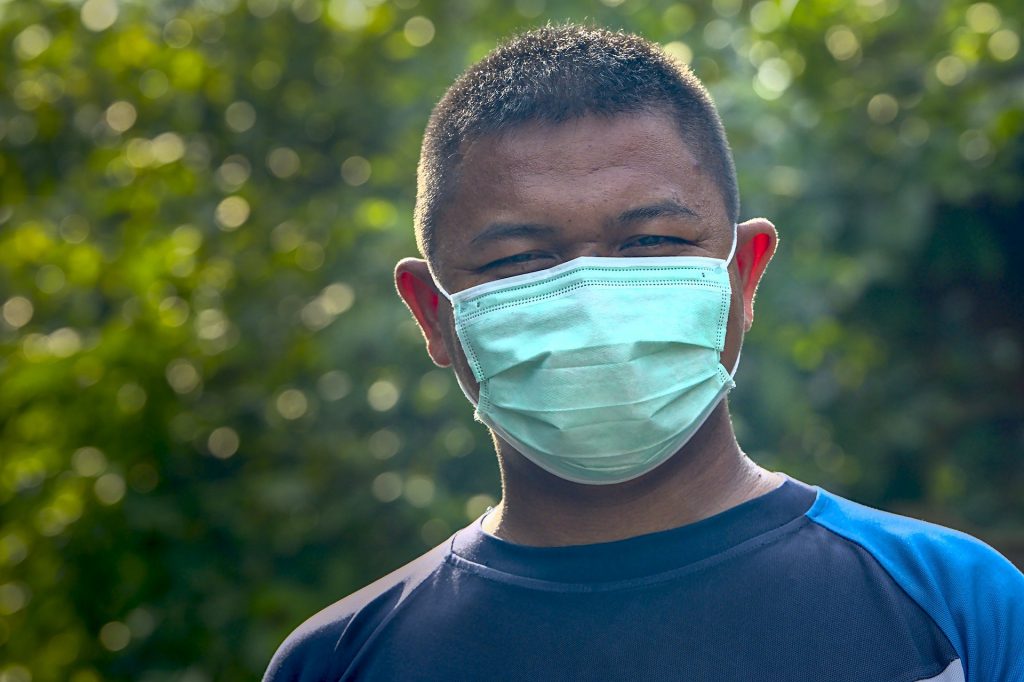A Mask Mandate is Not Enough
It's a step in the right direction, but not enough to suppress the virus.
Recently, the U.S. Bureau of Economic Analysis released its estimate of the US gross domestic product for the second quarter of this year (April through June). The chart below shows the percentage change from one quarter to the next since 1947.
As the chart shows, the recent decline is the largest the country has seen in over 70 years. This decline was expected after much of the economy shut down to tamp down the spread of the coronavirus. Declines in Europe have been equal or greater. The difference is in the outcomes. In much of Europe the virus was largely controlled as a result shut-downs. In the United States, it continues to spread wildly in areas across the country. Was the American economy sacrificed in vain?
There is general agreement among economists that the American economy will not recover until the virus is under control. Reopening prematurely just allows the virus to explode. Meanwhile, Congress dithers about authorizing the aid needed to help people who are hurt by the economic shutdown, which is, in turn, needed to slow the spread of the virus.
The politics regarding COVID-19 have become very strange. Oddly, it seems, many Republican politicians chose to ally themselves with the coronavirus, rather than with their constituents.
Polls find a majority of the public support mask requirements. For example, a national Yahoo poll from the end of July found that 77 percent of registered voters supported requiring masks in public places. This included 65 percent of Republicans and 59 percent of those who said they intended to vote for Donald Trump. (See here for a summary of polls on masks.)
Why are these people so hostile to masks? Perhaps part of the answer is the strange power President Trump holds over many of his voters.
Herman Cain attended Trump’s Tulsa Rally on June 20 and tweeted out the picture below along with the message: “Here’s just a few of the #BlackVoicesForTrump at tonight’s rally! Having a fantastic time!” 11 days later he was hospitalized with the coronavirus and later died.
Why did Cain decide to attend the event? The Tulsa rally was widely viewed in advance as a likely “super spreader” event, with a crowd of people close together, shouting and laughing, and not wearing masks, as documented in the photo Cain sent out. He fit into three groups particularly susceptible to the virus—male, aged 74 and a cancer survivor. By all accounts he was a skilled businessman, credited with turning around Godfather’s Pizza. Yet, he still attended this very dangerous event.
I am unaware of any American politician now or in history who generated the kind of credulous obedience that Trump does. That may be part of the reason that the United States has fared worse than any other nation at controlling COVID-19. When wearing a mask or any of the other steps needed to stop the virus is regarded as a political statement, stopping the coronavirus becomes much more difficult.
The chart below shows the number of new COVID-19 cases in Wisconsin since early March. The underlying data are taken from a database maintained by the New York Times. In order to compare states with differing populations, the number of new cases per day was converted to cases per 100,000 residents.
New York, New Jersey, and Connecticut require that travelers arriving from Wisconsin (and numerous other states) quarantine themselves for fourteen days. Wisconsin was placed on this list because its daily rate of new COVID-19 cases exceeds 10 per 100,000 residents (shown with yellow dashes on the chart). Similarly, having passed 15 cases per day for every 100,000 people (shown with purple dashes), Wisconsin was recently added to Chicago’s similar quarantine list. Having exceeded 10 daily cases per 100,000 residents (shown with yellow dashes).
In an article published May 13, Bruce Murphy observed that Wisconsin had the lowest number of new COVID-19 cases of any state in the upper Midwest. This situation was not to last. Coincidentally, the Wisconsin Supreme Court issued its decision lifting Wisconsin’s stay at home order on May 13.
The graph below tracks the number per-capita of new daily cases (using a 7-day moving average) in Wisconsin versus the other six Midwestern states. At the time of the court’s decision, Wisconsin shared with Michigan and Ohio the distinction of having the lowest per capita new cases.
A few weeks after the Wisconsin Supreme Court decision, Wisconsin’s new cases exploded, first leaving Michigan and Ohio behind, and then passing Illinois, Indiana, and Minnesota. Today, Wisconsin shares with Iowa the dubious distinction of having the highest new case rate in the upper Midwest. After Evers’ mask order, Iowa became the last of the seven states without a mask requirement.
Unfortunately, the graph makes clear that a mask order is not sufficient to reverse an upward trend of infections. Despite their mask orders, all these states see growing COVID-19 cases. All need to do more to control the pandemic.
The graph below shows the per capita daily cases in Milwaukee County compared to the WOW counties: Waukesha, Ozaukee, and Washington. Although the WOW counties have historically enjoyed relatively low COVID-19 caseloads, they have recently peaked. Both Milwaukee and Waukesha counties have high daily new case rates, around 25 per 100,000 residents. The other two WOW counties are lower but still disturbingly high.
And all three WOW counties follow the same pattern. Up to the end of June, they had low caseloads relative to Milwaukee. Suddenly, their cases take off. Two-thirds of Waukesha County’s total cases occurred in July. The July proportion is smaller for the other two counties but still over 50 percent. What explains this pattern?
The pre-July pattern probably can be explained by the region’s demographics. Most poor people in the Milwaukee metropolis live in the City of Milwaukee. They are particularly vulnerable to a disease that spreads like COVID-19, less able to isolate themselves from others, living with a larger number of people, and working jobs that cannot be done remotely.
Two amici briefs submitted to the Wisconsin Supreme Court illustrate the partisan divide. Endorsing the state’s stay-at-home order, the Wisconsin Association of Local Health Departments and Boards, along with several local health departments, argued that: “The public health response to COVID-19 must be a statewide response. We are stronger together when we rely on the authority the legislature granted DHS to take immediate action during a statewide pandemic.”
Washington County, in contrast, wrote that
DHS Exceeded its authority … because the primary responsibility for managing a public health crisis is vested by law in the County’s local health department. … DHS’s role is to serve as a backdrop to the local health officer when the local health officer is acting appropriately in managing the crisis in his or her jurisdiction.
The claim in the county’s brief is contrary to Wisconsin law. But given the county’s position, it is not surprising to find an article reporting that employees of the Ozaukee Washington Health Department “are being harassed by coronavirus skeptics in Ozaukee and Washington counties.” Leadership matters.
Ironically, the more successful the coronavirus skeptics are in discouraging the use of masks and other measures aimed at controlling the spread of the virus, the greater the need there will be for more intrusive measures such as closing non-essential businesses or limiting restaurant service to take-out.
The Wisconsin Supreme Court’s decision against the state’s stay-at-home order, along with the legislature’s refusal to negotiate a replacement, was a huge win for the coronavirus. The governor’s mask order is a step in the right direction but probably not enough to control spread of the virus, particularly with the return of cold weather and influenza in the fall.
More about the Coronavirus Pandemic
- Governors Tony Evers, JB Pritzker, Tim Walz, and Gretchen Whitmer Issue a Joint Statement Concerning Reports that Donald Trump Gave Russian Dictator Putin American COVID-19 Supplies - Gov. Tony Evers - Oct 11th, 2024
- MHD Release: Milwaukee Health Department Launches COVID-19 Wastewater Testing Dashboard - City of Milwaukee Health Department - Jan 23rd, 2024
- Milwaukee County Announces New Policies Related to COVID-19 Pandemic - County Executive David Crowley - May 9th, 2023
- DHS Details End of Emergency COVID-19 Response - Wisconsin Department of Health Services - Apr 26th, 2023
- Milwaukee Health Department Announces Upcoming Changes to COVID-19 Services - City of Milwaukee Health Department - Mar 17th, 2023
- Fitzgerald Applauds Passage of COVID-19 Origin Act - U.S. Rep. Scott Fitzgerald - Mar 10th, 2023
- DHS Expands Free COVID-19 Testing Program - Wisconsin Department of Health Services - Feb 10th, 2023
- MKE County: COVID-19 Hospitalizations Rising - Graham Kilmer - Jan 16th, 2023
- Not Enough Getting Bivalent Booster Shots, State Health Officials Warn - Gaby Vinick - Dec 26th, 2022
- Nearly All Wisconsinites Age 6 Months and Older Now Eligible for Updated COVID-19 Vaccine - Wisconsin Department of Health Services - Dec 15th, 2022
Read more about Coronavirus Pandemic here
More about the Statewide Mask Mandate
- Court Watch: Why Court Voided Evers Emergency Order - Gretchen Schuldt - Apr 5th, 2021
- Statement by Heartland Institute Director Jeré Fabick on WI Supreme Court Victory Against Gov. Tony Evers - Heartland Institute - Mar 31st, 2021
- Senator Agard: Statement on Supreme Court Decision - Dane County Executive Melissa Agard - Mar 31st, 2021
- Wisconsin’s Hyperpartisan Supreme Court is Endangering the Public - Democratic Party of Wisconsin - Mar 31st, 2021
- Wisconsin Supreme Court: Gov. Evers’ Multiple Emergency Declarations Violate Law - Wisconsin Institute for Law & Liberty - Mar 31st, 2021
- Rep. Hesselbein Statement on Supreme Court Ruling on Emergency Orders - State Senate Democratic Leader Dianne Hesselbein - Mar 31st, 2021
- Statement on Wisconsin Supreme Court Decision - State Sen. Jon Erpenbach - Mar 31st, 2021
- Gov. Evers Releases Statement Regarding Supreme Court Decision - Gov. Tony Evers - Mar 31st, 2021
- Rep. Hintz: Statement on Wisconsin Supreme Court Ruling - State Rep. Gordon Hintz - Mar 31st, 2021
- State Supreme Court Overrules Evers’ Emergency Powers - Laurel White - Mar 31st, 2021
Read more about Statewide Mask Mandate here
Data Wonk
-
The Imperial Legislature Is Shot Down
 Jul 10th, 2024 by Bruce Thompson
Jul 10th, 2024 by Bruce Thompson
-
Counting the Lies By Trump
 Jul 3rd, 2024 by Bruce Thompson
Jul 3rd, 2024 by Bruce Thompson
-
How Did Politics Affect Covid Deaths?
 Jun 26th, 2024 by Bruce Thompson
Jun 26th, 2024 by Bruce Thompson

























Another great analysis by Bruce Thompson. A belligerent minority is determining the fate of the State in terms of combatting the virus. I don’t hear any Republican elected officials being outraged abut the harassment and violent threats to our public health care professionals. Their rhetoric encourages it.